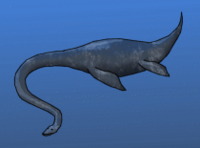|
Sauropterygians |
||||||||
|---|---|---|---|---|---|---|---|---|

Artistic recreation of a
plesiosaur
|
||||||||
| Scientific classification | ||||||||
|
||||||||
|
?Thalattosauriformes Placodontia Nothosauroidea Plesiosauria |
Sauropterygia ("lizard flippers") is a group of very successful aquatic reptiles that flourished during the Age of the Dinosaurs before they became extinct. They are united by a radical adaptation of their shoulder, designed to support powerful flipper strokes. Some later sauropterygians like the pliosaurs developed a similar mechanism in their pelvis.
The earliest sauropterygians appeared about 245 million years ago (Ma), at the start of the Triassic period. Early examples were small (around 60 cm), semi-aquatic lizard-like animals with long limbs (pachypleurosaurs), but they quickly grew to be several meters long and spread into shallow waters (nothosaurs). The Triassic-Jurassic extinction event wiped them all out except for the plesiosaurs. During the Early Jurassic these diversified quickly into both long-necked small-headed plesiosaurs proper, and short-necked large-headed pliosaurs. Originally it was thought that Plesiosaurs and Pliosaurs were two distinct superfamilies that followed separate evolutionary paths. It now seems that these were simply morphotypes in that both types evolved a number of times, with some pliosaurs evolving from plesiosaur ancestors, and vice-versa.
Each morphotype filled a specific ecological role. The large pliosaurs, like the Jurassic Rhomaleosaurus, Liopleurodon and Pliosaurus, and the Cretaceous Kronosaurus and Brachauchenius, were the superpredators of the Mesozoic seas, around 7 to 12 meters in length, and filled a similar ecological role to that of killer whales today. The long-necked plesiosaurs, meanwhile, included both those with medium-long necks, like the 3 to 5 meter-long Plesiosauridae and the Cryptoclididae, and the Jurassic and Cretaceous Elasmosauridae, which evolved progressively longer and more flexible necks, so that by the middle and late Cretaceous the entire animal was over 13 meters in length (e.g. Elasmosaurus), although as most of this was the neck, the actual body size was much smaller than that of the larger pliosaurs. These long-necked forms undoubtedly fed on fish, which they probably snared in their tooth-lined jaws with rapid lunges of the neck and head.
Disregarding reports of lake monsters like the Loch Ness Monster, they all perished 65 Mya during the Cretaceous-Tertiary extinction event.
Classification is difficult because the demands of the aquatic environment caused the same characteristics to evolve multiple times, illustrating convergent evolution. While sauropterygians are considered diapsids, they are also sometimes classified with turtles. The bulky-bodied, mollusc-eating placodonts may also be sauropterygians. In addition to the modifications of the shoulder, the group is also united by several modifications in their skulls.
Taxonomy
- Class
Sauropsida (reptiles)
- Infraclass
Lepidosauromorpha (lizards
and relatives)
- SUPERORDER SAUROPTERYGIA
- Order
Thalattosauriformes
- Suborder Thalattosauria
- Order Placodontia
- (unranked) Eusauropterygia
- Order
Nothosauroidea
- Suborder Pachypleurosauria
- Suborder Nothosauria
- (unranked) Pistosauroidea
- Corosaurus
Chinchenia
Kwangsisaurus
Cymatosaurus
Family Pistosauridae - Order
Plesiosauria
- Suborder Plesiosauroidea
(long-necked plesiosaurs)
Suborder Pliosauroidea (short-necked plesiosaurs)
- Suborder Plesiosauroidea
(long-necked plesiosaurs)
- Corosaurus
- Order
Nothosauroidea
- Order
Thalattosauriformes
- SUPERORDER SAUROPTERYGIA
- Infraclass
Lepidosauromorpha (lizards
and relatives)
External links
- Unit 220: 100: Lepidosauromorpha. Palaeos. July 15, 2003. Retrieved January 19, 2004.
- Sauropterygia: Flipper reptiles — longnecks and bigheads. T. Mike Keesey. The Dinosauricon. Retrieved January 19, 2004.
- A review of the Sauropterygia. Adam Stuart Smith. The Plesiosaur Directory. Retrieved April 17, 2006.
- Paleofile taxalist - lists every species and synonyms. Retrieved February 26, 2006